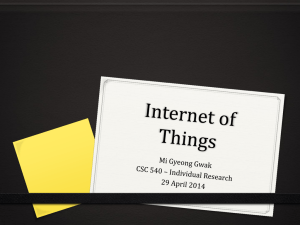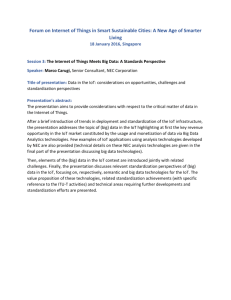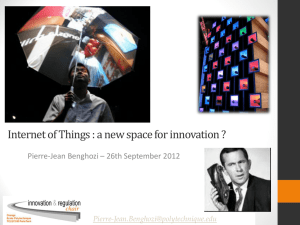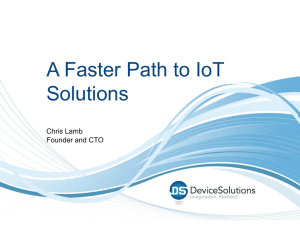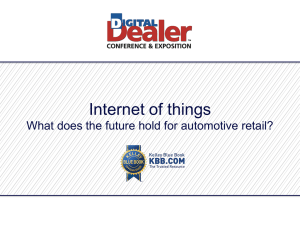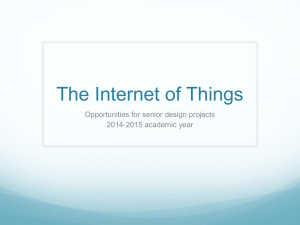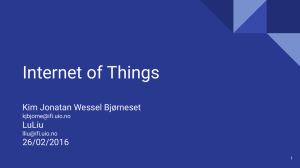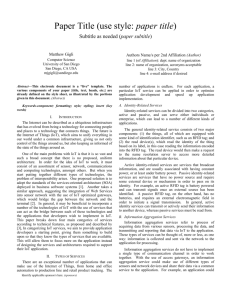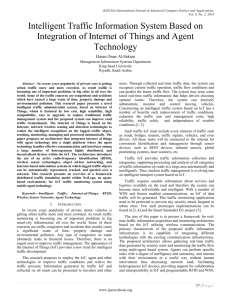What's Your End State Vision for the Internet of
advertisement
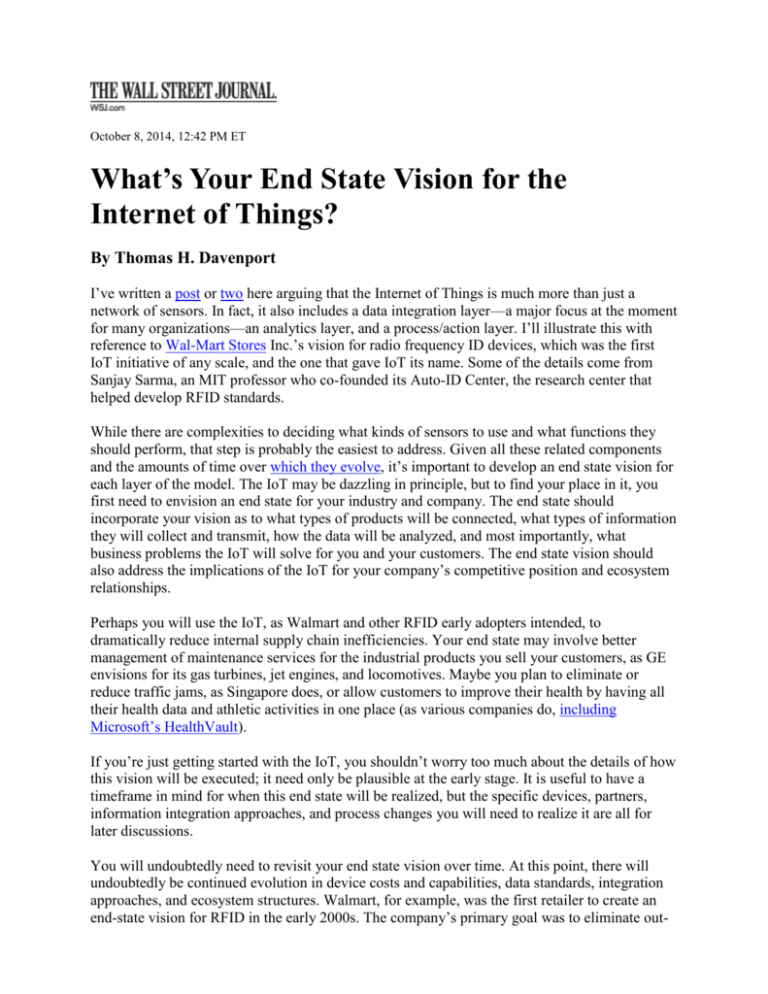
October 8, 2014, 12:42 PM ET What’s Your End State Vision for the Internet of Things? By Thomas H. Davenport I’ve written a post or two here arguing that the Internet of Things is much more than just a network of sensors. In fact, it also includes a data integration layer—a major focus at the moment for many organizations—an analytics layer, and a process/action layer. I’ll illustrate this with reference to Wal-Mart Stores Inc.’s vision for radio frequency ID devices, which was the first IoT initiative of any scale, and the one that gave IoT its name. Some of the details come from Sanjay Sarma, an MIT professor who co-founded its Auto-ID Center, the research center that helped develop RFID standards. While there are complexities to deciding what kinds of sensors to use and what functions they should perform, that step is probably the easiest to address. Given all these related components and the amounts of time over which they evolve, it’s important to develop an end state vision for each layer of the model. The IoT may be dazzling in principle, but to find your place in it, you first need to envision an end state for your industry and company. The end state should incorporate your vision as to what types of products will be connected, what types of information they will collect and transmit, how the data will be analyzed, and most importantly, what business problems the IoT will solve for you and your customers. The end state vision should also address the implications of the IoT for your company’s competitive position and ecosystem relationships. Perhaps you will use the IoT, as Walmart and other RFID early adopters intended, to dramatically reduce internal supply chain inefficiencies. Your end state may involve better management of maintenance services for the industrial products you sell your customers, as GE envisions for its gas turbines, jet engines, and locomotives. Maybe you plan to eliminate or reduce traffic jams, as Singapore does, or allow customers to improve their health by having all their health data and athletic activities in one place (as various companies do, including Microsoft’s HealthVault). If you’re just getting started with the IoT, you shouldn’t worry too much about the details of how this vision will be executed; it need only be plausible at the early stage. It is useful to have a timeframe in mind for when this end state will be realized, but the specific devices, partners, information integration approaches, and process changes you will need to realize it are all for later discussions. You will undoubtedly need to revisit your end state vision over time. At this point, there will undoubtedly be continued evolution in device costs and capabilities, data standards, integration approaches, and ecosystem structures. Walmart, for example, was the first retailer to create an end-state vision for RFID in the early 2000s. The company’s primary goal was to eliminate out- of-stock merchandise, and the RFID tags would go on pallets and cases to be read in distribution centers and stores. In 2003 the company announced that its top 100 suppliers needed to tag all shipments to distribution centers by 2005. Perhaps needless to say at this point, the great majority did not do so. The benefits from reducing out-of-stock merchandise would certainly accrue to both Walmart and its suppliers, but that was not enough to make most suppliers act at Walmart’s desired pace. Hence, a key lesson from RFID for IoT users is not to try to force adoption by other firms as a part of your vision—even if you have the size and power of Walmart. Slow and steady implementation—and carrots for supplier implementation, rather than the promised sticks— would probably have been more successful in the end. Walmart also learned that the locus of value from RFID was different from what it had anticipated. It found, for example, that the primary value from RFID was obtained in stores, not distribution centers. It found that RFID usage did deliver up to 16% reductions in out-of-stock merchandise, but it had to move to more selective use of the technology because of cost, process change requirements, and supplier inertia. Well over a decade after its sweeping supplier mandate, Walmart is still rolling out RFID and understanding its value. And since the IoT is much broader than RFID, it’s likely that the vision and value realization for companies will take even longer. With an end-state vision in place, companies then need to determine how quickly and aggressively to pursue it. Some companies will choose to actively shape their IoT environments (certainly Walmart’s choice), and others will be content with being shaped by others’ efforts. Some will choose, for example, to equip any new factory or facility with sensors to create the infrastructure for IoT; others will wait and try to retrofit. Some will try to hire the people now who are capable of designing and implementing IoT architectures; others will be willing to wait until more such people are trained on labor markets. Mr. Sarma argues that with RFID, many conservative companies blundered their way through incremental states that were successively worse. They felt that the cost of capital investments was too high to justify a major move. However, the real benefits of IoT come from broad, sweeping implementations that encompass not just devices, but the entire range of IoT activities that I mentioned. Companies like Walmart and Macy’s that have embraced RFID, developed a vision for it, and aggressively implemented all the way through business change are the ones that have achieved business value. Visions evolve over time, and are never implemented quite as envisioned. But the IoT course is long and complex enough so that it can’t be accomplished without a vision. To contradict Alice of “Looking Glass” fame and George Harrison, if you don’t know where you’re going, any road will not take you there. Thomas H. Davenport is a Distinguished Professor at Babson College, a Research Fellow at the Center for Digital Business, Director of Research at the International Institute for Analytics, and a Senior Advisor to Deloitte Analytics.


